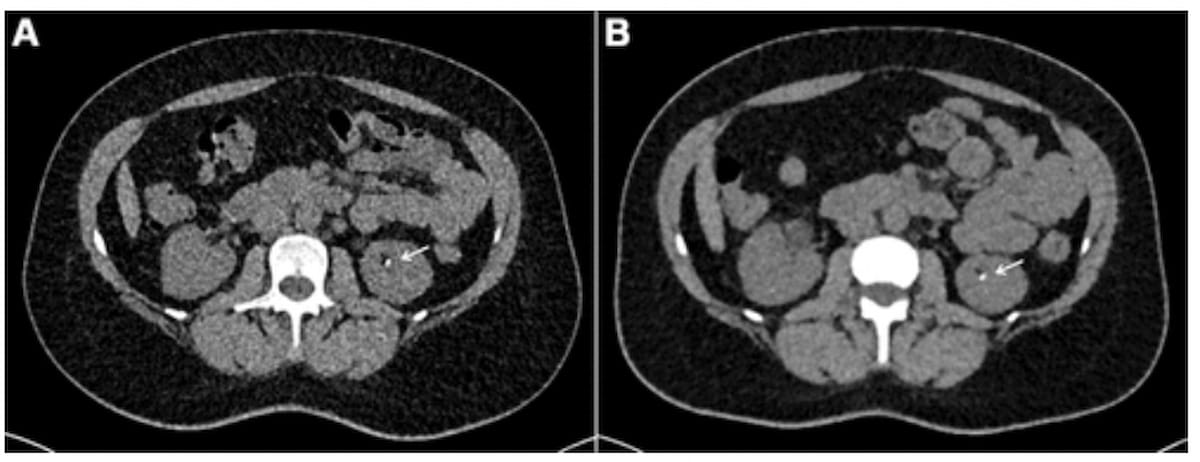Can photon counting detector CT (PCD-CT) provide enhanced visualization in suspected cases of kidney stones at significantly reduced radiation dosing in comparison to energy-integrating detector CT (EID-CT)?
For the retrospective study, recently published in Radiology, researchers compared the use of PCD-CT in 229 patients versus EID-CT in 278 patients for the detection of urinary calculi (kidney stones).1 For the entire cohort of 507 patients (mean age of 51.7), the study authors assessed signal-to-noise ratios (SNRs) at the kidney, psoas muscle and obturator muscle as well as reader confidence and agreement for three reviewing radiologists.
At an effective radiation dosing level of 0.79 mSv, PCD-CT provided a 30 percent higher SNR at the kidney level in comparison to EID-CT at a dosing level of 1.39 mSv (2.15 vs. 1.66), according to the study authors. The researchers also noted that PCD-CT had a 23 percent higher SNR at the psoas muscle (3.01 vs. 2.44) and a 17 percent higher SNR at the internal obturator muscle (3.25 vs. 2.79) in contrast to EID-CT.1
“In our study, we demonstrated that despite optimized acquisition settings on both scanners, photon-counting CT enabled considerable dose reduction compared with energy-integrating detector CT to facilitate diagnostic abdominal examination performance at radiation doses less than 1 mSv. Concomitantly, a substantial increase in image quality was ascertained despite the lower radiation exposure,” wrote lead study author Henner Huflage, M.D., who is affiliated with the Department of Diagnostic and Interventional Radiology at University Hospital Wurzburg in Wurzburg, Germany, and colleagues.
The researchers also noted “almost perfect” inter-reader agreement for both imaging modalities with respect to nephrolithiasis and urolithiasis detection, and a median reader rating of complete diagnostic confidence.
“Across all observers, the reader confidence was excellent, with no evidence of a difference between the PCD CT and EID CT groups,” added Huflage and colleagues.
Three Key Takeaways
1. Enhanced image quality with lower radiation. Photon-counting detector CT (PCD-CT) provided substantially higher signal-to-noise ratios (SNRs) at the kidney, psoas muscle, and obturator muscle compared to energy-integrating detector CT (EID-CT), despite a significantly lower radiation dose (0.79 mSv vs. 1.39 mSv for EID-CT).
2. Consistent diagnostic confidence. The study reported "almost perfect" inter-reader agreement for nephrolithiasis and urolithiasis detection, and a median reader rating of complete diagnostic confidence for both PCD-CT and EID-CT. This suggests that the lower radiation dose with PCD-CT does not compromise diagnostic confidence.
3. Significant radiation dose reduction for obese patients. PCD-CT facilitated considerable reductions in effective radiation dosing for obese patients with reductions of 40 percent, 39 percent, and 24 percent for obesity grades I, II, and III, respectively, compared to EID-CT. This may indicate a particular benefit for imaging in obese patients.
In a subgroup analysis, the researchers noted that PCD-CT facilitated 40 percent, 39 percent, and 24 percent reductions in effective radiation dosing for obesity grade I (1.17 mSv vs. 1.96 mSv), grade II (1.34 mSv vs. 2.22 mSv) and grade III (1.85 mSv vs. 2.43 mSv), respectively, in comparison to EID-CT.1
In contrast to related previous research that reported a 1.61 mGy mean CT dose index per volume, the study authors noted a 27 percent lower mean CT dose index per volume of 1.17 mGy.1,2
“Additionally, the observed relative increase in dose because of obesity was found to be lower in our study, indicating that patients with obesity benefit from this technology,” pointed out Huflage and colleagues.
(Editor’s note: For related content, see “Could Virtual Non-Contrast Images from Photon-Counting CT Reduce Radiation Dosing with CCTA?,” “FDA Clears Enhanced Mobile CT System with High-Resolution Photon-Counting Technology” and “Is Photon Counting CT a Better Option than Dual-Energy CT for Pulmonary Angiography?”)
Beyond the inherent limitations of a retrospective single-center study, the authors conceded there were no measurements of kidney stone sizes and an inability to quantify the amount of kidney stones depicted or missed on PCD CT due to the lack of successive CT scans.
References
1. Huflage H, Kunz AS, Patzer TS, et al. Submillisievert abdominal photon-counting CT versus energy-integrating detector CT for urinary calculi detection: impact on diagnostic confidence. Radiology. 2024;312(1):e232453.
2. Decker JA, Bette S, Lubina N, et al. Low-dose CT of the abdomen: initial experience on a novel photon-counting detector CT and comparison with energy-integrating detector CT. Eur J Radiol. 2022;148:110181.
